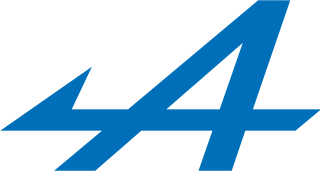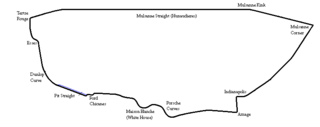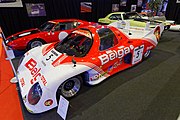
The Société des Automobiles Alpine SAS, commonly known as Alpine, is a French manufacturer of racing and sports cars established in 1955. The Alpine car marque was created in 1954.

Silverstone Circuit is a motor racing circuit in England, near the Northamptonshire villages of Towcester, Silverstone and Whittlebury. It is the home of the British Grand Prix, which it first hosted as the 1948 British Grand Prix. The 1950 British Grand Prix at Silverstone was the first race in the newly created World Championship of Drivers. The race rotated between Silverstone, Aintree and Brands Hatch from 1955 to 1986, but settled permanently at the Silverstone track in 1987. The circuit also hosts the British round of the MotoGP series.

The DFV is an internal combustion engine that was originally produced by Cosworth for Formula One motor racing. The name is an abbreviation of Double Four Valve, the engine being a V8 development of the earlier four-cylinder FVA, which had four valves per cylinder.

The Circuito del Jarama, formerly known as Circuito Permanente del Jarama is a motorsport racetrack located in San Sebastián de los Reyes, 20 miles north of Madrid. It was home to the Spanish Grand Prix nine times between 1968 and 1981, and the Spanish motorcycle Grand Prix 15 times between 1969 and 1988.

The Mirage Lightweight Racing Car was a family of race cars built by J.W. Automotive Engineereing (JWAE) at Slough in England, initially to compete in international sports car races in the colours of the Gulf Oil Corporation.

The 1982 24 Hours of Le Mans was the 50th Grand Prix of Endurance, which took place on 19 and 20 June 1982. It was also the fourth round of the 1982 World Endurance Championship. As well as a significant anniversary, this was a watershed year for Le Mans, with the highly anticipated advent of the FIA's Group C regulations, the essence of which was to allow an open engine formula but a minimum weight for safety and a proscribed fuel allocation.

The 1981 24 Hours of Le Mans was the 49th Grand Prix of Endurance, and took place on 13 and 14 June 1981. It was also the eighth round of the World Endurance Championship of Drivers, and the fifth round of the World Championship for Makes.

The 1980 24 Hours of Le Mans was the 48th Grand Prix of Endurance, and took place on 14 and 15 June 1980. It was the seventh round of both the World Championship for Makes and World Challenge for Endurance Drivers. With neither the Porsche nor Renault works teams contesting the big Group 6 sports-cars for outright victory, it left the prospects open for a privateer victory from Joest, Rondeau or De Cadenet, or from Group 5 again, if they were to fail. The wet weather throughout the race further added to the uncertainty, reducing the advantage of the more powerful cars.

The 1979 24 Hours of Le Mans was the 47th Grand Prix of Endurance, and took place on 9 and 10 June 1979. With no other major works cars this year, the Porsche team were the strong favourites to win. Their competition would be from Cosworth-powered Mirages and Rondeaus and a swarm of Group 5 and IMSA-class Porsche 935s. The other big talking point was the presence of Hollywood actor Paul Newman, driving for Dick Barbour Racing.

The 1978 24 Hours of Le Mans was the 46th Grand Prix of Endurance, and took place on 10 and 11 June 1978. In many ways it was a continuation of the race from the year before – the two main protagonists would be the very evenly-matched works teams of Alpine-Renault and Porsche, with four cars each. The race was not valid for any championship.

The 1977 24 Hours of Le Mans was the 45th Grand Prix of Endurance, and took place on 11 and 12 June 1977. The second year of the FIA Group 5 and Group 6 regulations, it produced an exciting race right up to the end. Porsche had withdrawn from the Group 6 Championship, citing a lack of broad competition. Renault, before their move into Formula 1, decided to put its main racing focus for the year onto Le Mans. The two works teams were the pre-race favourites.

The 1976 24 Hours of Le Mans was the 44th Grand Prix of Endurance, and took place on 12 and 13 June 1976. This year the FIA introduced its new Group 5 and Group 6 regulations and the race was now open to nine distinct classes, although it was still not part of the World Championship seasons. Porsche introduced its new models, the 936 in Group 6, the 935 in Group 5 and the 934 in Group 4. In response, BMW had its modified 3.0 CSL in Group 5. It was the year that turbos arrived in considerable numbers, with over a dozen turbocharged entries, led by the Renault Alpine A442. It saw the arrival of French prototype manufacturers Jean Rondeau and Gérard Welter in a new GTP class and a first-time invitation to American IMSA and NASCAR entries.

Jean Rondeau was a French race car driver and constructor, who won the 24 Hours of Le Mans in 1980, in a car bearing his own name, an achievement which remains unique in the history of the race.

The Lotus 23 was designed by Colin Chapman as a small-displacement sports racing car. Nominally a two-seater, it was purpose-built for FIA Group 4 racing in 1962–1963. Unlike its predecessors Lotus 15 and 17, the engine was mounted amidship behind the driver in the similar configuration developed on Lotus 19.

The Rondeau M382 was a Group C prototype sports car, designed, developed and built by Automobiles Jean Rondeau in 1981, and used in sports car racing between 1982 and 1986.
The following are results from the automobile and motorcycle races contested at the Circuit de la Sarthe and Bugatti circuits in Le Mans, France.

The Osella PA3 is a Group 6 prototype racing car designed, developed, and built by Osella, to compete in the World Sportscar Championship sports car racing series in 1975, but was used in active competition through 1986. It was powered by a number of different engines, including the 2.0 L (120 cu in) BMW M12/7, the Abarth twin-cam engine, and the Cosworth BDG, or the 1.3 L (79 cu in) Cosworth BDH, or even the smaller the smaller 998 cc (60.9 cu in) Cosworth SCA. The 1.6 L (98 cu in) and 1.8 L (110 cu in) Cosworth FVA and Cosworth FVC were also used. It was even powered by a Ferrari 2.0 V8 engine.

The Rondeau M482 was a Group C sports car prototype, designed, developed and built by Automobiles Jean Rondeau in 1982, and used in sports car racing until 1987.

The Rondeau M379 is a Group 6 sports prototype race car, designed, developed and built by Automobiles Jean Rondeau, and competed in sports car racing between 1979 and 1988. It also notably successfully won the 24 Hours of Le Mans in 1980. During the 1981 24 Hours of Le Mans, two cars finished on the podium, but the race was marred by the death of Jean-Louis Lafosse, driving one of the five M379s entered in the event. It achieved one further win, at Monza in 1988. It scored a total of five podium finishes, and three class wins. It was powered by a 3.0 L (180 cu in), 460 hp (340 kW), Ford-Cosworth DFV V8 Formula One engine.The chassis is an aluminum-reinforced steel spaceframe, covered in a fiberglass panel body. This drove the rear wheels through a Hewland 5-speed manual transmission. This meant it was very light, with the total weight coming to 760 kg (1,680 lb).

The Inaltéra GTP is a Group 6 sports prototype race car, designed, developed and built by Automobiles Jean Rondeau in 1976.


















